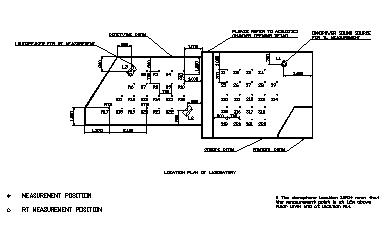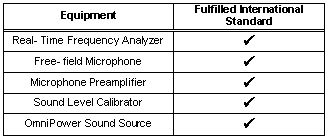|
Sound Transmission Loss Measurement |
Complied with:
- BS EN ISO 140-3: 1995 (BS 2750 Part 3: 1995) and BS EN ISO 717-1:1996
- BS EN 1793-2:1998 and BS EN 1793-3:1998
- ASTM E90
When sound is incident
upon a building element some of it will be reflected and some will be
transmitted through the wall. The fraction of incident energy transmitted
is called the transmission coefficient . The sound reduction index , is
in turn defined in terms of the transmission coefficient.
The sound reduction index of a partition is measured in a laboratory by
placing the element in an opening between two adjacent reverberant rooms.
Noise is introduced into one of the rooms, source room, part of the sound
energy is transmitted through the test element into the other room, receiving
room. The resulting mean space-average sound pressure levels between 100
Hz to 5000 Hz in one-third-octave band in the source and receiving rooms
are measured.
The receiving room constant is determined by measurements of the reverberation
decay. When measuring reverberation time in a room, the sound source is
driven by a random noise generator in series with a bandpass filter. When
the sound is turned off the room rate of decay is measured by the frequency
analyser. The reverberation time, in each frequency band is determined
as the reciprocal sound pressure level decay rate. The slope, generally
measured as the best straight line fit to the recorded decay between 5dB
and 35dB down from the initial steady-state level, is used to determine
the decay rate.
A single number descriptor, weighted sound reduction index Rw is used
to facilitate comparison of the performance of different element. To determine
the Rw for a particular element, a curve fitting technique is used to
fit the calculated one-third octave sound reduction index.
Rw contours consist of a horizontal segment from 1250 to 3150 Hz, a middle
segment increasing by 5 dB from 400 to 1250 Hz and a low frequency segment
increasing by 18 dB from 100 to 400 Hz. The Rw rating of an element is
determined by plotting the one-third octave band level of the element
and comparing it with the Rw contours. The Rw contour is shifted vertically
until the curve falls mainly below the contour and the sum of the deficiencies
below the contour over the 16 one-third octave bands does not exceed 32
dB is met.
When the Rw contour is shifted to meet these criteria, the Rw rating is
given by the value of the contour at 500 Hz.
There is a very similar rating developed by ASTM which is called STC. This uses a sightly different frequency range (125 - 4000 Hz versus 100 - 3150 Hz for Rw) and includes a limitation of no point more than 8dB below the rating curve in any one-third-octave band. In general, the two ratings give either the same number or only 1-2 points difference, so they can be used fairly interchanged.
Our acoustics laboratory fulfills the requirement
listed in ISO-140, and the experimental result of the building specimen
is applicable to ISO 140-3, ASTM E-90 and BS 2750.
Acoustics Laboratory and Facility
Our laboratory consists of two connecting reverberation rooms. The source
and receiving are of 90m3 and 75m3. This was satisfied the requirement
of ISO-140 and ASTM E-90 for sound insulation testing. The receiving room
is built on an isolation box to ensure efficient vibration and sound isolation.
The building specimen was installed in the 10m2 opening. The support frame
for the specimen was fixed to a concrete platform, which was isolated
from both source and receiving rooms. This is to reduce the transmission
of structure-borne vibration from the structure of the source room.
Laboratory Dimension: View ![]()
To ensure the highest accuracy and precision of our measurement, our equipment
is complied with the requirements of accuracy classes 0 or 1 defined in
IEC 651 and IEC 804.
|
|
|
Sophisticated Equipment |
Certify Your Buildings Specimen
Once finished laboratory measurement, a detail measurement report , and
a Certification that relevant to the Sound Reduction Index (RW) of the
tested buildings specimen will be issued. People can refer to this Certification
to consult the acoustics performance of your building products. No more
estimation, true data is here.
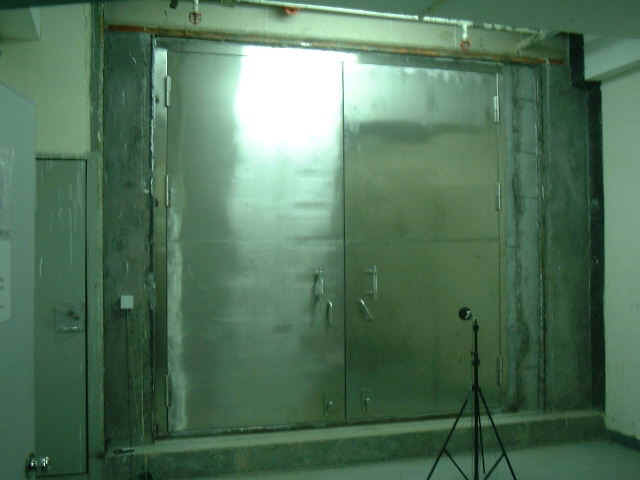 |
||
| Testing of Acoustics Door | ||
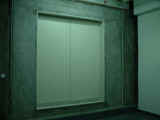 |
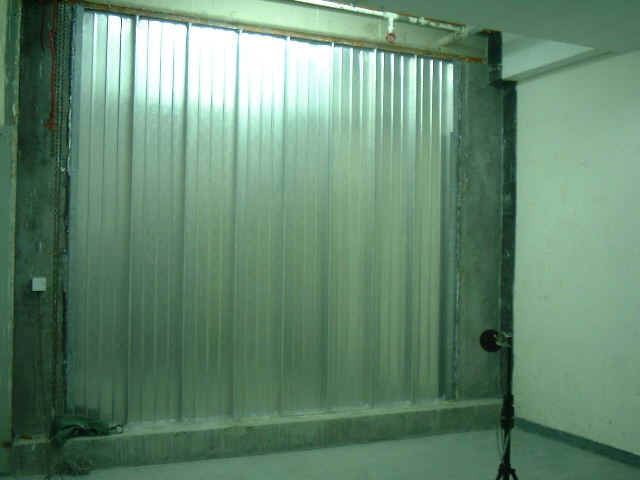 |
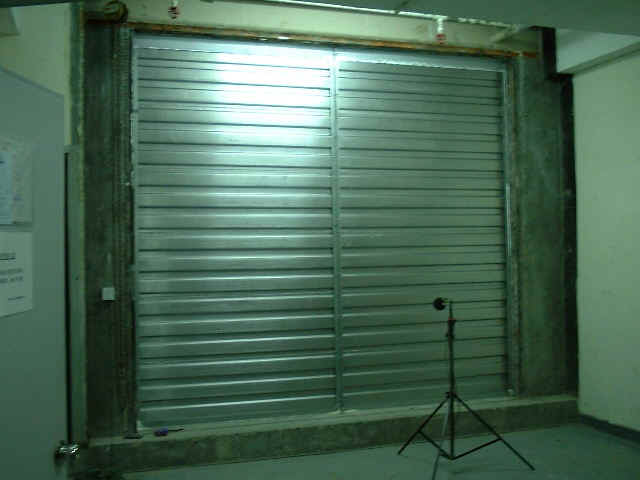 |
| Testing of Panel | Testing of Acoustics Barrier | Testing of Acoustics Panel |
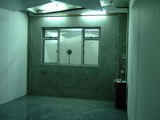 |
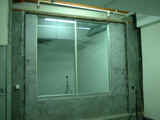 |
|
| Testing of Windows | Testing of Windows |
Job Reference
1. Hong Kong Housing
Authority (1996)
Laboratory Sound Reduction Index Measurement according to BS 5821: 1984
Part I for comparison of uPVC and Aluminium flamed windows.
2. Maze Aluminium Engineering Company Ltd. (1996)
Transmission Loss Measurement for Airport Fire station and Police station
Glass Cladding System.
3. Paliburg Development Consultants Ltd. (1997)
Window System Acoustics Mock-up Test for Proposed Hotel Development at
Chek Lap Kok.
4. Far East Aluminium Works Co. Ltd. (1997) .
Transmission Loss Measurement for Cathay Pacific CLK Headquarters Metal
and Glass Cladding System.
5. Maxii High-Technique Engineering Co. Ltd. (1998)
Laboratory Sound Reduction Index Measurement of Roofing, External Wall
and Internal Partition Wall according to ISO 140-3
6. Campbell Shillinglaw Cook & Associates Ltd. (1998)
Transmission Loss Measurement for Roofing System of CPA Flight Training
Centre for Associated Engineers Ltd.
7. Research Engineering Development Facade Consultants
Ltd. (1998)
Laboratory Sound Reduction Index Measurement for Aluminium Window for
Far East Aluminium Works Co. Ltd. according to ISO 140-3:1995.
8. MBM (H.K.) Ltd. (1998)
Laboratory Sound Reduction Index Measurement for Curtain Wall for King's
Road Project according to ISO 140-3: 1995.
9. ENPAC Ltd. (1998)
Laboratory Sound Reduction Index Measurement for Aluminium Window in accordance
with ISO 140-3: 1995.
10. Architectural Acoustics (H.K.) Ltd. (1999)
Laboratory Sound Reduction Index Measurement for Acoustic Panel in accordance
with ISO 140-3: 1995.
11. Felix Construction (H.K.) Ltd. (1999)
Laboratory Sound Reduction Index Measurement for Internal Wall Cladding
Panel according to ISO 140-3: 1995.
12. Luen Shing Decoration Engineering and Trading Co.
(1999)
Laboratory Sound Reduction Index Measurement for Aluminium Window according
to ISO 140-3: 1995.
13. Flour City Architectural Metal (Asia) Ltd. (1999)
Laboratory Sound Reduction Index Measurement of Mock-up Test for South
Wall of Main Block at Chek Lap Kok according to ISO 140-3.
14. Kelly Construction Co. Ltd. (2000)
Transmission Loss Measurement for Cinema Auditoria Party Wall for CityPlaza.
15. NANIWA International Co. Ltd. (2000)
Laboratory Sound Reduction Index Measurement for V-Block according to
ISO 140-3: 1995.
16. Builders Federal (H.K.) Ltd. (2000)
Transmission Loss Measurement for Acoustic Louvre.
17. Campbell, Shillinglaw, Lau Ltd. (2000)
Laboratory Sound Reduction Index Measurement for Acoustic Panel according
to ISO 140-3: 1995.
18. SPS Co. Ltd. (2000)
Laboratory Sound Reduction Index Measurement for Double Sandwich Board
according to ISO 140-3: 1995.
19. Campbell, Shillinglaw, Lau Ltd. (2000)
Transmission Loss Measurement for Metal Roof System according to ASTM
E336 for CLP Power Hong Kong Limited Science Park Project.
20. S. M. Engineering Ltd. (2000)
Laboratory Sound Reduction Index Measurement for Metal Roof System according
to ISO 140-3: 1995 for CLP Power Hong Kong Limited West Kowloon Reclamation
'A' Substation and Maintenance Depot
21. Elewinton Ltd. (2000)
HOKLAS Accredited Laboratory Sound Reduction Index Measurement for Double
Leaf Acoustic Door according to ISO 140-3: 1995.
22. Yung Shing Machinery Engineering Co. Ltd., Taiwan
(2001)
HOKLAS Accredited Laboratory Sound Reduction Index Measurement for Acoustic
Door and Acoustic Window according to ISO 140-3: 1995.
23. Industrial Acoustics Company (HK) Ltd. (2001)
HOKLAS Accredited Laboratory Sound Reduction Index Measurement for Acoustic
Barrier Panels according to ISO 140-3: 1995 for MTRC Contract 520A Stage
1.
24. Wins Consultants Ltd. (2001)
HOKLAS Accredited Laboratory Sound Reduction Index Measurement for 125mm
Drywall System of WINS Panels according to ISO 140-3: 1995
25. Hofmann Chen (Taiwan) Limited (2001)
HOKLAS Accredited Laboratory Sound Reduction Index Measurement for 125mm
Drywall System of Perlitec S. Boards according to ISO 140-3: 1995
26. Daido Building Materials Co. Ltd. (2001)
HOKLAS Accredited Laboratory Sound Reduction Index Measurement for 100mm
YTONG Panel Wall according to ISO 140-3: 1995
27. Proflex Office System Limited (2001)
Laboratory Sound Transmission Loss Measurement for PROWALL Full Ceiling
Height Demountable Panel System according to ASTM E90
28. Saffire Acoustic Engineering Limited (2001)
Laboratory Sound Reduction Index Measurement for Operable Wall Panels
for Medical Complex, HKU.
29. Techwell Engineering Limited. (2001)
HOKLAS Accredited Laboratory Sound Reduction Index Measurement for "KAIZIP"
Roof System according to ISO 140-3: 1995 for West Rail, KCRC
30. CEMAC Engineering Limited. (2001)
HOKLAS Accredited Laboratory Sound Reduction Index Measurement for two
acoustic door panels according to ISO 140-3: 1995 for TVB Project.
31. Industrial Acoustics Company (HK) Ltd. (February-March
2002)
HOKLAS Accredited Laboratory Sound Reduction Index Measurement for Acoustic
Barrier Panels according to ISO 140-3: 1995 for MTRC Contract 520A Stage
2.
32. Yung Shing Machinery Engineering Co. Ltd., Taiwan
(March 2002)
Laboratory Sound Reduction Index Measurement for Acoustic Door of 2100mm
by 945mm according to ISO 140-3: 1995.
